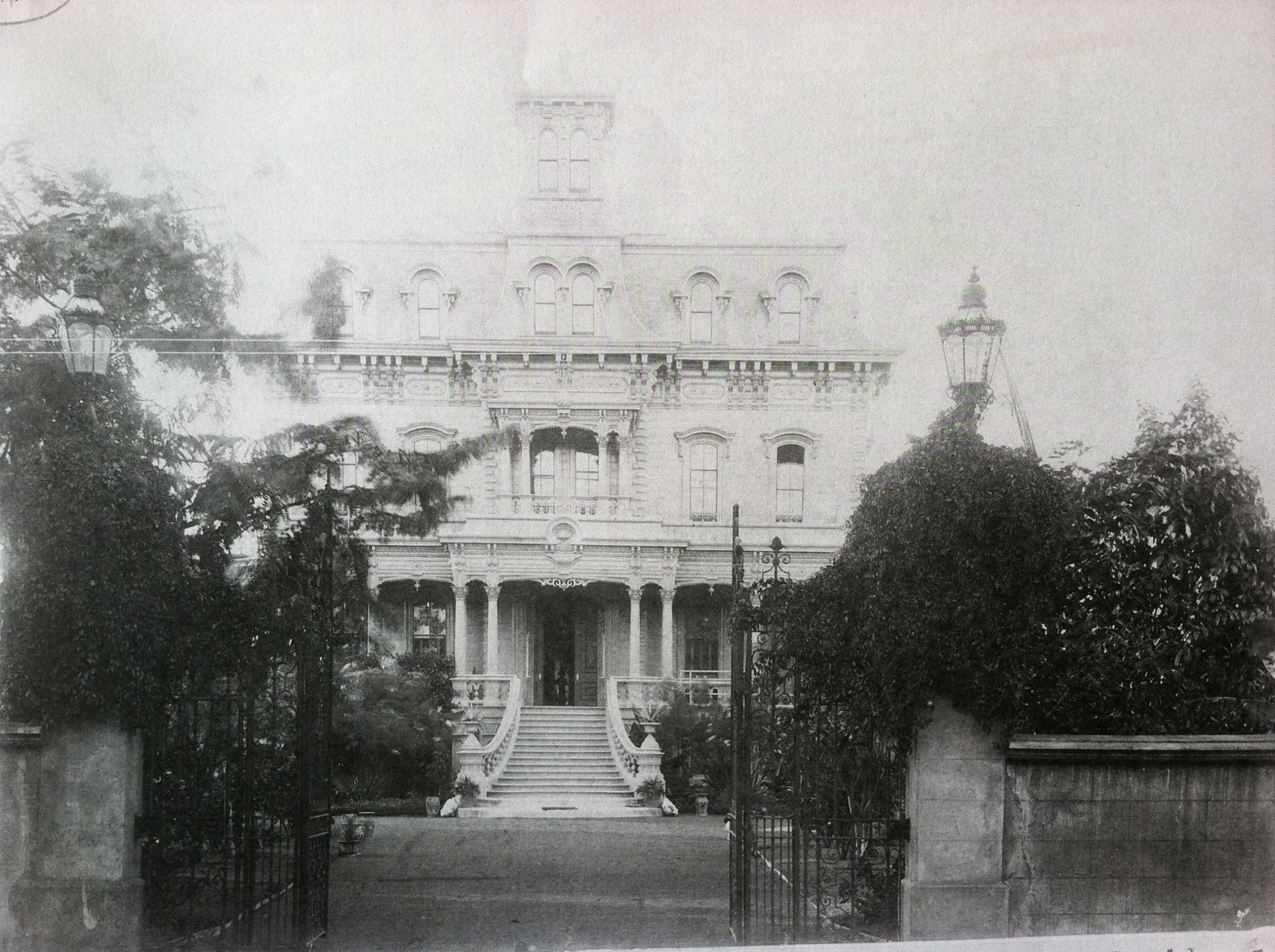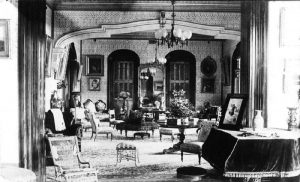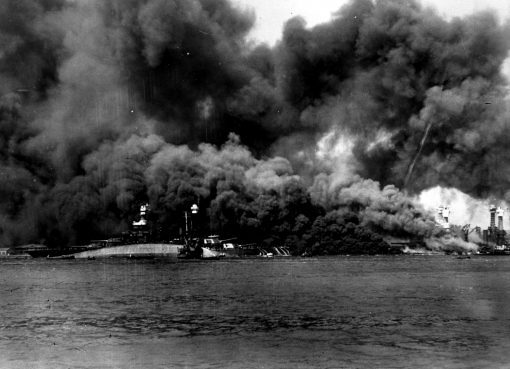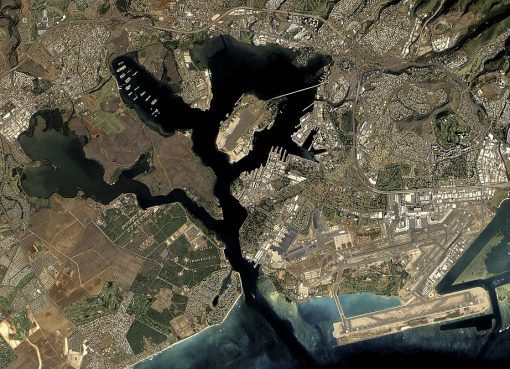Keoua Hale: The History of the Palace of Princess Ruth Keelikolani























Keōua Hale, once located at 21 Emma Street in Honolulu, was a grand Victorian-era palace built by one of the last Kamehameha descendants, Princess Ruth Keelikolani. Completed in 1882, It was the most elaborate and most expensive home built in the Hawaiian Islands at that time. (Zambucka, p. 66)
Princess Ruth Keelikolani was born February 9, 1826, in Pohukaina, Oahu to Kekuanaoa and Pauahi of the Royal lineage of King Kamehameha I. She was great-granddaughter of Kamehameha I, grandniece to Kamehameha II and III and half-sister to King Kamehameha IV and King Kamehameha V.
When Princess Ruth saw a photo of a Nob Hill mansion in a San Francisco newspaper, she found her style inspiration for Keoua Hale. (Kawailahaole, 1939, p. 1) She hired Charles J. Hardy, an architectural designer from Chicago, to design her palace in the Second Empire style like those of Nob Hill. (Peterson, 1963, p. 22) Pictured here is the James Flood mansion.
Keoua Hale was built in the Second Empire style with a Mansard roof and dormered windows. It was constructed of wood.
Keoua had two drawing rooms on the main floor. The smaller drawing room was at the front of the building and measured 24 feet by 19 feet, and the larger drawing room behind it was 48 ½ by 24 ½ feet. This photo from 1883 shows its cornices, eight-foot wide arched doorways and elaborate plasterwork. The painting hanging to the right of the right windows hang today in their original frames in Bishop Museum (inset).


The grand drawing room was 48 by 24 feet and featured two six-light bronze chandeliers and four bay windows. According to several accounts, folding doors could separate the drawing rooms if desired, but otherwise would “slide away out of sight into the walls.”(Pacific Commercial Advertiser, 1882, p. 2)
The walls were wallpapered with highly elaborate Victorian patterns and decorative plasterwork. The light green ceiling featured the Hawaiian coat of armor in its detailed designs.
No known photos of the ceilings exist, but from several accounts, an Italian artist elaborately painted them in fresco. “In his choice of colors for the various parts of the molded work, and of ground colors and designs for the flat portion of the ceilings he has been peculiarly happy,” according to the Pacific Commercial Advertiser on November 13, 1881.
The exterior landscaping included a water lily pond and three “beehive” foundations. (Hoyt, 1977) A 10-foot wall surrounded the entire grounds except for the entries, enclosed with a decorative iron gate. (Peterson, 1963, p. 22)
Concave mansard roof
Belt course
Quoins
Cupola
Paired dormered windows
Molded cornices
Cresting along the roofline
Bay windows
Paired brackets
Hooded windows
Observatory (cupola)
Attic
Second Floor
Entry/ Main Floor
Raised basement
The front gates were moved to Bishop Museum where they stand today. (Inset)

There were 10 foot wide lanais on both sides and back of the house. The lanais featured Corinthian pillars and decorative balustrades.
Just blocks from Ruth’s Kaakopua property, Kalakaua built Iolani Palace. Likewise, Princess Ruth built her own palace with her personal wealth, named “Keōua Hale.”
Iolani Palace
Keoua Hale

Keōua Hale, once located at 21 Emma Street in Honolulu, was a grand Victorian-era palace built by one of the last Kamehameha descendants, Princess Ruth Keelikolani. Completed in 1882, the hale was a testament to grandeur, being the most elaborate and expensive home built in the Hawaiian Islands at that time. Its architectural magnificence was a sight to behold, a true marvel of the Victorian era. After serving as a private residence, it served primarily as an educational resource for its short life, finally demolished in 1926 to make way for Central Intermediate School.
About Princess Ruth Keelikolani
Princess Ruth Keelikolani was born February 9, 1826, in Pohukaina, Oahu, to Kekuanaoa and Pauahi of the Royal lineage of King Kamehameha I. She was the great-granddaughter of Kamehameha I, grandniece to Kamehameha II and III, and half-sister to King Kamehameha IV and King Kamehameha V.
Princess Ruth Keelikolani’s early life was marked by significant personal loss. Her mother, Pauahi, tragically died while giving birth. Queen Kaahumanu, the favorite wife of King Kamehameha, then took on the responsibility of caring for Ruth until she, too, passed away in 1832 when Ruth was just six years old. These early losses undoubtedly shaped Ruth’s character and resilience, making her a figure worthy of empathy and understanding.
Ruth was born during one of the most turbulent times in Hawaii’s history. In 1819, the kapu, the religious order, and rule of the land was overthrown. The next year, Christian missionaries from the United States arrived in Hawai‘i and set out to convert Hawaiians to Christianity, a significant shift in the cultural and religious landscape of the islands. Ruth’s birth in this era of profound change and upheaval adds a layer of historical weight to her story.
Princess Ruth’s bookkeeper, Oliver Kawailahaole, recalled, “In her youth, she was a beauty; in older life old Hawaiian will now tell you, little children cried when they saw her, they were that frightened.” [2]
“The outstanding thing about Princess Ruth was her temper,” Kawailahaole said, “She wouldn’t stop short of picking up a calabash and flinging it at her retainers!”
Building a Palace
After the death of her half-brother, King Kamehameha V, Keelikolani was not chosen as successor to the throne, and her cousin, David Kalākaua, was elected King in 1874. She did, however, inherit great wealth through the land once belonging to chiefs and alii were passed along to her.
Just blocks from Ruth’s property at Kaakopua, Kalākaua began constructing a grand, elaborate replacement of the Iolani Palace to position the Hawaiian Kingdom as a peer to other great monarchies across the globe. Likewise, Princess Ruth began building her palace with her wealth, named “Keōua Hale,” after her favorite ancestor, to symbolize her position as Hawaiian royalty. “The building of Keōua Hale was a symbolic assertion of Ruth’s power and status,” according to George Kanahele in his book Pauahi: The Kamehameha Legacy. [3]
A photo of a Nob Hill mansion inspired Ruth when she saw it in a San Francisco newspaper.[4] She hired Charles J. Hardy, an architectural designer from Chicago, to design her palace in the Second Empire style like those of Nob Hill. [5]
Princess Ruth’s attorney, Simon K. Kaai, was the site construction manager of Keōua Hale and its landscape designer. Kaai was Princess Ruth’s financial agent and held several government posts, including Deputy Sheriff of Kona, Minister of Finance, and Minister of the Interior. He died in Hawaii in 1884.
John E. Bowler was the primary builder of Keōua Hale and was a well-known plasterer in Hawai’i. Keōua Hale was to be his greatest work, but he is also in the history books as the first to build a sidewalk in Hawaii.[6] He was associated with Enterprise Planing Mill on Oahu. He was a significant supporter of the royal family of Hawaii. He pledged his oath to the Hawaiian government in 1885, renouncing his United States citizenship. Later, in 1895, he was charged with “treasonous acts” for participating in a revolt organized by Robert Wilcox. He appealed to the U.S. for protection but was denied since he had given up his citizenship the previous decade.[7] He was later pardoned, but his involvement in Hawaii ceased soon after.
The Architecture of Keōua Hale
Keōua Hale, constructed in the Second Empire style, boasted a center-towered layout, a large covered lanai, stringcourses, and a grand covered porch entry. The use of wood materials and the shingled, concave mansard roof with dormered windows added to its unique charm. The structure, spanning five stories, included the observatory (cupola) level, the Attic level, the second floor, and the main level, all on a raised basement level.
The ground floor of the main building at Keōua Hale was a testament to its grandeur, with 16-foot ceilings and a layout that included two drawing rooms, two bathrooms, two bedrooms, a grand hall, and a staircase. A broad lanai to the rear of the main building led to the dining hall, kitchen, and pantry, completing the luxurious living space.
The entry hall at Keōua Hale was a sight to behold, with a width of 13 feet and a length of 65 feet. The predominant feature was a lightly carpeted koa staircase set against walls adorned with koa paneling. The plasterwork was equally impressive, featuring keystones, arches, egg-and-dart moldings, and brackets with a “strikingly handsome pattern… borrowed from the capitals and pediments of Doric architecture.”[8]

Two drawing rooms to the right of the entry hall (see Figure 2) with eight-foot-wide arched doorways. The smaller drawing was at the front of the building and measured 24 feet by 19 feet, and the larger drawing room behind it was 48 ½ by 24 ½ feet. According to several accounts, folding doors could separate the rooms if desired, but otherwise would “slide away out of sight into the walls.”[9] The walls were wallpapered with highly elaborate Victorian patterns and decorative plasterwork. The ceiling featured the Hawaiian coat of armor in its detailed designs.
No known photos of the ceilings exist, but from several accounts, an Italian artist elaborately painted them in fresco. “In his choice of colors for the various parts of the moulded work, and of ground colors and designs for the flat portion of the ceilings he has been peculiarly happy,” according to the Pacific Commercial Advertiser on November 13, 1881.
To the left of the entry, opposite the drawing rooms, were two bedrooms with two bathrooms. The main bedroom, Princess Ruth’s bedroom, was furnished with a large four-poster bed. Ten-foot-wide covered lanais framed both sides of the ground floor and the back of the main building but did not connect to the grand lanai at the front. They featured Corinthian pillars and decorative balustrades. [10] A broad-covered lanai attached a large dining room to the back of the main building. The room was 29 ½ feet by 24 ½ feet with ceilings at 14 feet tall. Behind the dining room was a pantry and kitchen.[11] Springfield Air Gas provided the lighting and was the technology of great envy. Some 125 burners lit the house with brass gasoliers. Brown & Phillips were local agents who supplied the system.[12]
The second floor consisted of two guest bedrooms over the formal bedroom and a smaller drawing room on the main floor. Their décor was much simpler than the ground floor’s and covered with wood paneling.
The exterior landscaping included a water lily pond and three “beehive” foundations.[13] A 10-foot wall surrounded the entire grounds except for the entries, enclosed with a decorative iron gate. [14]
Construction of Keōua Hall began in 1879[15], and the Pacific Commercial Advertiser announced on July 2, 1881, that “the new mansion for H.H. Ruth Keelikolani is almost ready for occupation.”[16]
A grand opening party lasted three days in commemoration of Princess Ruth’s 56th birthday on February 9, 1882. The Pacific Commercial Advertiser reported, “Altogether, little short of a thousand must have paid their respects to Her Royal Highness on her birthday, many of whom were personally unknown to her, but to whom she had generously extended hospitality worthy of the sister of Kings.”[17]
Princess Ruth only spent one night in Keōua Hale. According to historian and author Helen Hoyt, it had taken ten assistants to help her up the steps to the main floor of Hale Keōua. “She decided to spend the night in the formal bedroom on the first floor where there was a large four-poster bed,” Hoyt said. “With much labor, her attendants helped her up the three steps leading to the bed. She lay there sleepless all night and when the morning came she decided to go back to her one-story bungalow in the backyard and lie on her pile of lauhala mats. From there she could watch her palace and its garden with no effort at all. She never went into her palace again.” [18]
Keōua Hale Enters a Second Era
On May 23, 1883, Ruth died in Kailua; her remains were returned by ship to Honolulu to lie in state in the drawing room of Keōua Hale for three weeks, “during which all the native marks of respect accorded to chiefs of high rank were observed.”[19]
Bernice Pauahi Bishop inherited most of Princess Ruth’s land, including Keōua Hale. She and her husband, Charles Reed Bishop, moved into Keōua Hale on October 9, 1884, where on October 16, 1884, Princess Bernice Pauahi, the last direct descendant of King Kamehameha I, died at 12:12 p.m.[20] Like Princess Ruth, she lay in state in the rear drawing room at Keōua Hale until November 2, 1884.[21]
Upon his wife’s death, Charles Reed Bishop became the owner of Keōua Hale, which remained his primary residence until he left Hawaii after the overthrow of the Hawaiian monarchy in 1893. When he moved to California in 1894, Bishop arranged for his niece, Cordelia Church Bishop Allen, and her husband, William F. Allen, to be resident hosts of the Keōua Hale. [22] At the same time, the most precious heirlooms, family portraits, artwork, and cultural artifacts that belonged to the Bishops were transferred to the newly formed Bishop Museum. Other furnishings were given to the Allens and his other relatives, such as the E. Faxon Bishop family. [23]
As was customary for cross-ocean moves of that day, Bishop auctioned most of his household furnishings, including those he inherited from his wife Bernice and those from Princess Ruth. On March 9, 1895, the Pacific Commercial Advertiser published the notice of the auction by James Morgan of furnishings at the Emma Street palace, which were to occur on March 12 and March 18. According to the ads, items to be sold included “Heavy plate glass dressing mirrors with marble mantels, Mahogany Chairs and Tables, French Walnut Office Table, ebony parlor suite upholstered in brocaded silk, inlaid center and side tables, 1 Koa State Bedstead, Mahogany and koa wardrobes, 1 B.W. mirror front wardrobe, B.W. pillar extension table, French walnut sideboard, bureaus, B.W. sideboard, koa tables, etc., etc. etc.” [24]
According to the March 18 Pacific Commercial Advertiser, D.B. Smith purchased the four-poster bed and planned to send it to the mainland for exhibition.[25]
From Palace to High School
Wanting to dedicate the land and Keōua Hale to educational purposes, Charles Reed Bishop negotiated with the Republic of Hawaii to sell them the property, including its 4.31 acres of land, for $30,000 to be used as Hawaii’s first high school. On August 20, 1895, the Republic of Hawaii passed Act 22, issuing funds to purchase Keōua Hale for “educational use.”
In October 1895, Honolulu High School, the first and only high school in Hawaii, opened its doors.[26] In 1905, the high school moved to Linekoa and later to McKinley High School. The former Keōua Hale was converted to Central Grammar School in 1907.
In 1923, The Friend reported that the historic palace, former high school, and grammar school were to be razed that summer [27] due to termite damage and insufficient space for the student population. The cleared land would be used for what is now Central Intermediate School. According to Central Intermediate School, the building was not demolished until 1926. [28]
The building that exists today was completed in 1927 [29] and shares some features, such as pillars, with Keōua Hale. Other than the name “Keelikolani” in bold letters on the side of one of the buildings, very few physical reminders of its royal past remain today.
The large iron gates adorned with a “B” while Keōua Hale served as home to Charles Reed and Pauahi Bishop are installed at the side building entrance walkways at the Bishop Museum. Several paintings that once hung on the walls in the drawing rooms at Princess Ruth’s now hang in the Kāhili Room at the Bishop Museum.
During its short lifetime, this building hosted legendary soirees, witnessed the deaths of the last Kamehameha descendants, became the first high school in Hawaii, and was nationally recognized for its unique connection to Royalty and cosmopolitan student body.[30] When Keōua Hale was demolished in the 1920s, a historic building was lost, and so was a remarkable work of art.
Endnotes
[1] (Zambucka, p. 66)
[2] (Kawailahaole, 1939)
[3] (Kanahele, 1986, p. 163)
[4] (Kawailahaole, 1939, p. 1)
[5] (Charles E. Peterson, 1963, p. 22)
[6] (The Daily Bulletin, 1886, p. 2)
[7] (The Daily Bulletin, 1895, p. 2)
[8] (Pacific Commercial Advertiser, 1882, p. 2)
[9] (Pacific Commercial Advertiser, 1882, p. 2)
[10] ibid
[11] (Pacific Commercial Advertiser, 1882, p. 2)
[12] ibid
[13] (Hoyt, Princess Ruth Palace Had a Very Short Life, 1977, p. 1)
[14] (Charles E. Peterson, 1963, p. 22)
[15] (The Hawaiian Gazette, 1879)
[16] (Pacific Commercial Advertiser, 1881, p. 3)
[17] (Pacific Commercial Advertiser, 1882, p. 2)
[18] (Krout, 1908, p. 222)
[19] (Pacific Commercial Advertiser, 1883, p. 2) and (The Friend, 1923, p. 135)
[20] (Krout, p. 222)
[21] (Krout, p. 223)
[22] (Kamehameha Schools, 2011)
[23] Ibid.
[24] (The Daily Bulletin, 1895, p. 4)
[25] (The Daily Bulletin, 1895)
[26] (Williams, 1895, p. 151)
[27] (The Friend, 1923, p. 135)
[28] (Central Intermediate School, 1976)
[29] (Central Intermediate School, 1976)
[30] (The Pacific Commercial Advertiser, 1905, p. 5)
Sources Cited
- Central Intermediate School. (1976). The Past In Review: The History of Central Intermediate School. Honolulu, HI: Central Intermediate School.
- Charles E. Peterson, F. (1963). Pioneer Architects and Builders of Honolulu. Hawaiian Historical Society Seventy-Second Annual Report for the year 1963, 7-28.
- Hoyt, H. P. (1977). Princess Ruth Palace Had a Very Short Life. Honolulu, HI: Central Intermediate School.
- Hoyt, H. P. (Unknown). Princess Ruth Palace Had a Very Short Life. Honolulu, HI: Central Intermediate School.
- Kamehameha Schools. (2011, November 1). Kamehameha Schools. Retrieved November 1, 2011, from http://www.ksbe.edu/crbt/benefactor
- Kanahele, G. H. (1986). Pauahi: The Kamehameha Legacy. Honolulu: Kamehameha Schools Press.
- Kawailahaole, E. B. (1939, May 20). He Recalls Princess Ruth. The Honolulu Star-Bulletin.
- Kent, H. W. (1958). Charles Reed Bishop Man of Hawaii. Honolulu: Kamehameha Schools Press.
- Krout, M. H. (1908). The memoirs of Hon. Bernice Pauahi Bishop. New York: The Knickerbocker Press.
- Liliuokalani, Q. (1898). Hawaii’s Story by Hawaii’s Queen. Boston: Lothrop, Lee & Shepherd Co.
- Pacific Commercial Advertiser. (1881, July 2). Pacific Commercial Advertiser, p. 3.
- Pacific Commercial Advertiser. (1882, February 18). Birthday of Her Royal Highness Princess Ruth Keelikolani. Pacific Commercial Advertiser, p. 2.
- Pacific Commercial Advertiser. (1883, June 02). Pacific Commercial Advertiser, p. 2.
- Pacific Commercial Advertiser. (1881, July 2). News. Pacific Commercial Advertiser, p. 3.
- Ronck, R., & Schmitt, R. C. (1995). Firsts and almost firsts in Hawai’i. Honolulu: University of Hawaii Press.
- The Daily Bulletin. (1895, March 11). (March 11) Local and General News. The Daily Bulletin, p. 8.
- The Daily Bulletin. (1895, March 13). (March 13) Local and General News. The Daily Bulletin, p. 3.
- The Daily Bulletin. (1895, March 09). Notice of Auction. The Daily Bulletin, p. 4.
- The Daily Bulletin. (1886, March 26). News. The Daily Bulletin, p. 3.
- The Daily Bulletin. (1895, May 03). News. The Daily Bulletin, p. 2.
- The Friend. (1923, June). Historic Land-Mark To Be Razed. The Friend, p. 135.
- The Hawaiian Gazette. (1879, August 06). News. The Hawaiian Gazette.
- The Pacific Commercial Advertiser. (1905, June 9). Rapid Growth of Territory’s Fine High School. The Pacific Commercial Advertiser, p. 5.
- Williams, J. (1895, October 01). High School Building, Honolulu. Paradise of the Pacific, p. 151.
- Zambucka, K. (1992). The High Chiefess Ruth Keelikolani. Honolulu: Green Glass Productions.



